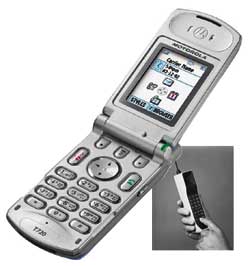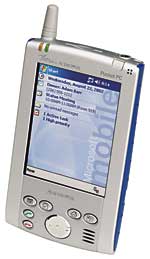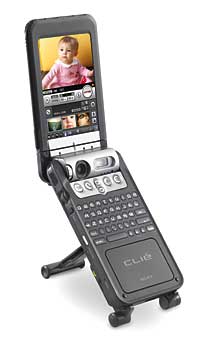|
|
||||||
|
From
heavyweight to wafer in 20 years
In 1983 the first mobile phone weighed 8kg and cost $4,000 by Alan Zisman (c) 2003 First published in Business in Vancouver , Issue #700 March 25-31, 2003 Gear Guide column
Motorola is celebrating 20 years of mobile phones. In 1983, the world's first cell phone, Motorola's DynaTAC 8000x weighed almost eight kilograms, let you talk for 30 minutes, and could go a full eight hours between charges. Oh yes, the price was some $3,995 in 1983 dollars.
The T720 flip-phone is bridging the gap between simple mobile phones and PDAs; it uses Java-based technology allowing users to download additional features, and includes a standard POP3 e-mail client. It can be synchronized with your computer, PDA, or Web-based services to keep phone numbers and calendars up to date. There's even an optional MP3 player and FM radio add-on. While
the
T720 might be described as a mobile phone morphing into a
PDA, from the other direction, PDAs have been morphing into phones,
adding wireless communication features.
In past columns, we've seen how fans of the Palm operating system (and GSM subscribers) can opt for Handspring's Treo, available in both monochrome and colour-screen models. Competition to the Treo, from Palm's Tungsten-W is coming soon to the GSM phone networks (which will be grist for a future GearGuide column). If you prefer Microsoft's Pocket Windows-powered PDAs, you needn't feel left out of this tech-trend, however. Telus Mobility (along with Bell Canada Mobility east of Alberta) is offering subscribers the Audiovox Thera. A full-featured Pocket Windows PDA, it offers a crisp colour screen and scaled-down versions of Microsoft Word, Excel, PowerPoint and Outlook.
The built-in SB555 modem (from Vancouver's Sierra Wireless) gives it network and Internet access at speeds ranging from 60 to 144 Kbps (easily comparable to land-line modems) along with a full range of CDMA network mobile phone features. It can be used as a speakerphone or via the bundled earphone/mike. Like the Palm-powered models, Web-browsing and e-mail are much more satisfying with the larger screen and better text-input of a PDA than on cell phones, even models with PDA-pretensions like the T720. Unlike the Treo and Tungsten-W models, there's no mini-keyboard on the Thera. As with most other PDA models, be prepared to enter data with a stylus. Battery life is not great: 10 hours if you're just using the PDA. Turn on the phone or modem and it plummets to three hours talk-time, closer to 1983's DynaTAC than Motorola's current T720. The phone book displays all the names and phone numbers stored in the PDA Contact list, but you can't dial directly from the Contact application.
All in all, Thera is a good Pocket Windows PDA with excellent data communication features (watch the cost of data services!) but the phone features are more awkward than in dedicated cell phones (or Handspring's Treo). If you don't need something with phone capabilities, but want the ultimate Palm-powered PDA (at least for now), the current model-to-beat is from Sony, the $1,299 Clie PEGNZ90. Featuring a 200 MHz processor and Palm's new OS 5.0 (only currently available in a single model from Palm itself), it also opens up into a two-part case with a built-in keyboard for easier text input. Other features include a high-resolution colour screen, MP3 player and a built-in two-megapixel digital camera (with flash), for photos as large as 1600 x 1200 pixels. Built-in Bluetooth connectivity lets you connect it to Bluetooth-enable cell phones or computers, and an optional wireless networking card offers the ability to hook into the wide range of WiFi base stations for Internet access or even access to your local area network. |
||||||
|
|
||||||
|
|
||||||
| Alan Zisman is a Vancouver educator, writer, and computer specialist. He can be reached at E-mail Alan |



